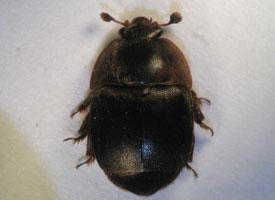
Greutăți și măsuri
| Lungime | de la 5 la 6 m |
|---|
Descrierea animalului
The Small Hive Beetle (Aethina tumida) is a small, yet significant pest that poses a threat to bee colonies across various parts of the world. Originating from sub-Saharan Africa, this beetle has since spread to many other regions, including North America, Australia, and parts of Europe, causing considerable concern among beekeepers and agriculturists due to its destructive impact on honeybee hives.Typically measuring between 5 to 7 millimeters in length when fully grown, the Small Hive Beetle is characterized by its oval shape and dark brown to black exoskeleton, which can sometimes appear as a slightly lighter brown depending on the beetle's age and diet. Its head is tucked underneath the thorax, not visible from a top view, and it possesses clubbed antennae that are a distinctive feature useful for identification. The larvae are creamy white in color, with a segmented body that can grow up to 10-11 millimeters in length, featuring a pair of small spines at the rear end, which aid in their movement within the hive.
The life cycle of the Small Hive Beetle is closely intertwined with that of the honeybee. Female beetles lay their eggs in cracks and crevices within the bee hive, choosing spots that are close to bee brood or stored pollen and honey. Upon hatching, the larvae feed on the hive's resources, including honey, pollen, and even bee brood. This feeding frenzy not only causes direct damage by consuming the bee's food source but also leads to the fermentation and spoilage of honey stores, making them unusable and leading to a condition known as "slime-out" where the hive becomes overrun with the sticky, fermenting waste produced by the beetle larvae. This can result in the abandonment of the hive by the bee colony, a devastating outcome for both the bees and the beekeeper.
Adult beetles are also a nuisance in the hive. They can be found hiding in crevices during the day and are more active at night when they feed on pollen, honey, and bee brood. Their presence causes stress to the bees, which can weaken the colony and make it more susceptible to diseases and other pests.
Control and management of the Small Hive Beetle require vigilant monitoring by beekeepers, who use a variety of methods to keep beetle populations in check. These methods can include physical barriers to prevent beetle entry, traps placed inside or outside the hive to capture adult beetles, and maintaining strong, healthy bee colonies that are better able to defend against invaders. Chemical controls are also available, but their use is often limited due to the potential harm to the bees and the contamination of hive products.
In its native habitat, the Small Hive Beetle is considered less of a threat, as local bee species have evolved alongside the beetle and have developed strategies to cope with its presence. However, in regions where the beetle has been introduced, the local bee populations, particularly the European honeybee (Apis mellifera), have not developed these defenses, making them particularly vulnerable to the beetle's destructive habits.
The spread of the Small Hive Beetle globally is a concern for biodiversity, agriculture, and economies, especially in areas heavily reliant on beekeeping and pollination services provided by bees. Efforts to understand the biology, behavior, and control of the Small Hive Beetle continue, as the global beekeeping community seeks to mitigate the impact of this invasive pest and protect the health and productivity of honeybee colonies around the world.
Fotografii noi cu animale
Top 10 animale
- Dolphin gull (Leucophaeus scoresbii)
- Diana monkey (Cercopithecus diana)
- Galápagos tortoise (Geochelone nigra complex)
- Moustached guenon (Cercopithecus cephus)
- Japanese spider crab (Macrocheira kaempferi)
- Colossal squid (Mesonychoteuthis hamiltoni)
- Stone loach (Barbatula barbatula)
- Fox tapeworm (Echinococcus multilocularis)
- Japanese macaque (Macaca fuscata)
- Barbary macaque (Macaca sylvanus)